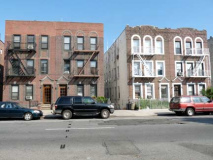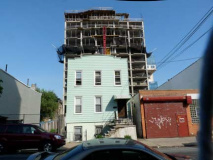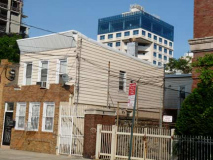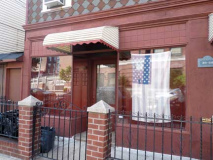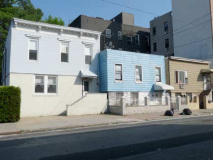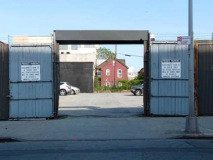I had a meeting the other day in Astoria and thought I would walk Crescent Street down to Queens Plaza — unfortunately I couldn’t beat rush hour and let about 4 #7 trains go by till I found one with sufficient breathing space. Crescent Street has always been a puzzler for me, at least, since I’m not sure why it was permitted to keep its name when the Great Queens street Numbering was executed back in the 1920s. The streets runs from the Con Ed property in northeast Astoria all the way to 4th Drive in Dutch Kills and takes the place of 25th, 24th, 28th, and then 25th again from NE to SW, although 26th Street is also absent between 24th and 27th. (25th is one of the shortest of all Queens numbered streets, running for only 2 blocks from 50th to Borden in Hunter’s Point)
19th Century maps show a curved road called The Crescent between today’s 30th and 34th Avenues, and that slant is still in evidence today as Crescent Street is not purely parallel to its brothers between those two avenues to this day. Though it’s one way (except for between 30th and Newtown Avenues), it is a little wider than the rest and can handle two lanes of traffic. Crescent Street has also been called Prospect Street in the past, and that original bend may have been meant to get it around a hill that Prospect Street also referred to.
Are there archetypal NYC multifamily buildings? There are the attached brownstones found in vast swaths of Brooklyn and the Bronx, the townhouses on Manhattan’s side streets, and even the prewar tenements whose alarmingly bad conditions were called out by reformers like Jacob Riis. I grew up in a 20-unit apartment building and then lived in buildings with six and later, 16 units. But the varieties at left are relatively unsung — they probably date from 1920 to 1940 and are no nonsense with not a lot of ornamentation or gewgaws. The building at left has nicely paned front doors and a pyramidical pediment, while the building at right has arched top windows. As the big bad wolf found, brick is the sturdiest method of building residential buildings.
On the right we see a contrast on Crescent Street between old Dutch Kills and new Dutch Kills, as the area is being bombarded with high rise hotels that adjoin much older buildings.
Old Crescent hangs on as Dutch Kills becomes a taller neighborhood. Right: There are relatively few storefronts on Crescent Street, so this display window is a mystery.

The ultimate high rise addition to Dutch Kills came in 1989, when the aquamarine 50-story Citigroup Tower (known officially as #1 Court Square) was opened. The building is a twin of sorts to the slant-roofed Citigroup Center on East 53rd between 3rd and Lexington Avenues. The Queens tower can be seen by looking directly east along E. 53rd, or south on Crescent Street. This building is the tallest on the East Coast (outside Manhattan) between Boston and North Carolina.
The classic low-rise Dutch Kills, quickly being run over by developers in this non-landmarked area. Through a parking lot for Orkin Pest Control, you can spot what could be a 19th Century house.
5/27/11


